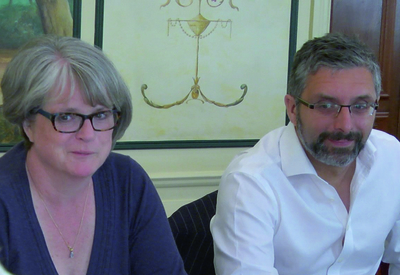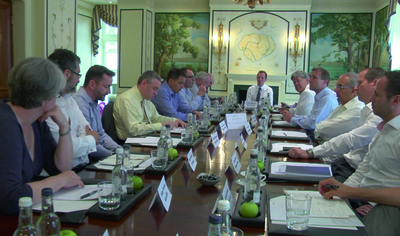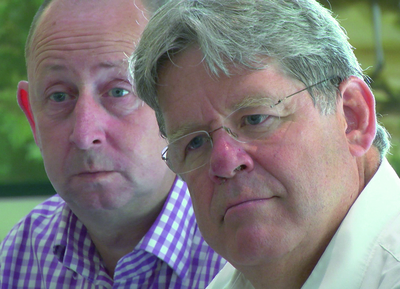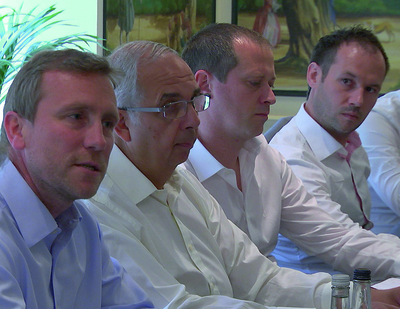(L-R) Roger Severn, Aquatint BSC, Spencer Slee and Ivor Jacobs, Ivor Solutions, Nick Muarry, Wellington Press and Adam Brown, Hollinger Press
The economy and its impact on the print sector, and issues of diversification, partnerships and finance were the subjects of the day as Digital Printer and partner Ricoh hosted another Strategies for Success roundtable debate at the Savoy. Andy Knaggs presided as chair.
Acculitho Repro is a family company based in Barnet, north London. It has both litho and digital printing capability and is looking to enter the web to print market. After a tough time in 2011, things have picked up since it installed a Ricoh Pro C651 in 2012, with 20% growth year on year. The higher end Ricoh press, the C901, has also just entered the Acculith factory.
No big deal in any of that information – it seems a common enough tale. Acculith has also entered the dye sublimation market though, and has the ability to print onto a vast range of different objects and materials. Suddenly its story has an unexpected twist.
Gaby Purton, one half of the husband and wife team that runs Acculith, explained: ‘We went to Fespa last year. No-one had asked us to do sublimation but I use social media a lot to advertise what we do and we have developed the market since. It wasn’t a huge outlay at all, but it was well worth it. It’s a 150% mark up. You have to be proactive. We get a lot of high value work through social media, £2000, £3000 work. If you sit and wait for it to happen it will go elsewhere.
‘The other thing is, we looked at our outgoings and that’s why we brought in a lot more finishing capabilities. Dye sublimation means we can do totally different work: name badges, iPad cases, t-shirts – things that we would have to outsource. It is marketed through social media and we are upselling to current customers. If they don’t know what you do how can you sell it? You have to educate people.’
It was a story of considerable interest to all those in attendance at the ‘Strategies for Success – where do we go from here?’ event, held at The Savoy in June, but not necessarily one that everyone intends to apply to their own business. Adam Brown of Hollinger Press in Norfolk can see different priorities ahead before such diversification becomes necessary.

Gaby Purton, Acculith, and Rhys Morgan, DP Direct
He said: ‘For us, I can see doing the same thing working quite well. We can focus on efficiencies in production – there are so many areas where we can make it more profitable, and for the next couple of years I believe we can continue to do really well. At some point we will look to diversify, but without doing it we can be more profitable just by doing what we are doing better and running a tighter ship in-house. We can still make money on the print as we are.’
Ivor Solutions is another that has diversified, although its diversification came in moving into print in the first place, after beginning as a software company. When there is diversification now, said Ivor Jacobs, it is driven by customer demand. ‘We could go into virtually anything – coloured paper, dye sublimation – but it will be led through customers bringing work in,’ he said.
On the other hand, print companies might choose the viewpoint of Robert Grundy of Passion Print in London’s West End. He said: ‘We are good at what we do. Starbucks sell coffee and make a lot of money. Our client base is within one square mile of our front door. It’s about service and quick turnaround. We are running jobs that are in at 10am, and out to clients at 4pm. They love it. They are paying a premium for it. We are good at what we do.’
What should we take from these differing perspectives? Simply perhaps that there are too many dimensions, too many possible circumstances involved, to a question such as ‘must printers diversify to survive?’ for there to be a straight-forward answer.
Cost versus income
Having listened to several answers from around the table, Tony Matthews of London City Print turned the question around somewhat. Everyone had been talking about income but not about cost, he observed.
‘The click charge has increased massively but the sale price has dropped. Paper prices have increased ten-fold while I’ve been in business but the sale price is down a quarter,’ he said. ‘We all work as individuals and franchises that don’t work. There’s no fight back when paper companies dictate paper prices. We all fight for our own businesses. There is no group that works to buy electricity together. I feel that’s where we will step out of the market.’

The comment gives rise to further questions about the value that printers might find from adopting a different approach to partnering with like-minded and/or complementary companies. Roger Severn of Aquatint BSC had this response to give: ‘There’s more collaboration with printers these days than ever before. There is far more openness now. We find the BPIF to be quite good at putting people together. We supply St Ives and they have put us on their buying group, and prices have gone down by 15%.’
There may be economic advantages to groups of printers linking arms to negotiate better rates, but a familiar obstruction gets in the way, said Nick Murray of Wellington Press: ‘We could find savings in everything we buy, but it’s finding time. A number of us in the same region, why not?’ and with a wink towards the hosts Ricoh: ‘Let’s start with clicks!’
Reducing costs is certainly something that should be at the forefront of every printer’s mind, judging by Rhys Morgan’s observation. The DP Direct executive said: ‘I’ve spoken to procurement people from the automotive industry, who told me that 5% of cost is equivalent to a 25% increase in sales. What’s easier to achieve: flogging more goods or getting that 5%?’
Finding funding
The conversation moved on to the subject of finance: what was their experience of trying to raise funding as the economy has emerged from the doldrums? Gaby Purton answered: ‘Getting the finance for the new Ricoh was extremely easy for us, but the banks are still very reluctant to lend to SMEs, which is a shame.’

(L-R) Tony Matthews, London City Print, and Roger Severn Aquatint BSC
The question rapidly gave way to a discussion about invoice finance, something that a number of the participants were engaged in. The subject was introduced by Robert Grundy of Passion Print, who revealed that he started using it when he bought out the assets and goodwill of the company a year ago. ‘That was a total breath of fresh air, but they all come with traps; you’ve got to be on the ball with their rates and costs. There’s no way I could have started the business without it. Going forward, and a year down the line, all the equipment is Personal Guaranteed, absolutely everything.’
This was a concept that Wellington Press’s Nick Murray would have no part of. ‘I resent Personal Guarantees when I’ve been in business for years and I’ve left value in the business. I won’t PG a machine. I might as well rip it out and lease it back to all the companies in London. I may as well run the business as a shell with nothing behind it.’
Gaby Purton of Acculith said she would not touch invoice financing, having used it for a year to get through a tricky period. ‘We got out as quickly as possible when we looked at the costs,’ she added.
Ivor Jacobs had a different funding suggestion. His business, Ivor Solutions, had also used invoice discounting before, but more recently it has changed tack. ‘It was really difficult to get funding but last year we were doing some acquisitions, and the bank let us down so we went to crowd funding. Within two weeks we had got all the funding we needed. The ways of borrowing now are changing and hopefully changing in our favour, although you have to be very careful of interest rates.’
Takeaways
With the end of the roundtable’s allotted time slot approaching, the panel were invited to share their thoughts on what they would take from the discussion. Several said they had been inspired somewhat by Gaby Purton’s commitment to social media and the results she was gaining. Others were intrigued about the potential for the industry to change its image – to move away from describing itself as print to something that may be viewed more positively by others outside of print. Some were looking ahead to developing web to print and were considering diversification.
Most, however, appreciated the opportunity to talk openly with like-minded professionals. Adam Brown of Hollinger Press said: ‘It has been really valuable to listen to other people; how open everyone is has been amazing. There’s a lot of food for thought to take back, including realising that print is not just about paper anymore. You cannot afford to stand still as a business and you need to get out there and get involved.’
Disc to Print UK’s Andrew Cumming said that it was exciting to see that there is an appetite for collaboration among other companies, which has not always been there, while Dave Sharpe from Twist Print ended the discussion with an optimistic prediction: ‘It is good to hear about people having the same problems as you. I think we are all going to do really well this year. I believe we will get a lot more print and that’s our core business.’





